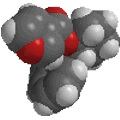 |
Basic IUPAC Organic Nomenclature
|
 |
Basic IUPAC Organic Nomenclature
|
| The most common chirality center in organic chemistry is a carbon atom with four different groups attached |
STUDY TIP This is an area where having a model kit and using it is a great idea (at least until you are comfortable with the concept and the process) |
Common mistakes made by students:
Example: chlorofluoroiodomethane
|
|
The chirality center should be easy to spot, and the four attached groups are in priority order, highest to to lowest: I (purple), Cl (green), F(brown) and H (white) Rotate the image on the left so the you are looking along the C-H bond
and the H is away from you, then determine the direction of high
to low priority. |
 |
 |
 |
 |
 |
 |
| starting point | identify the chirality center(s | assign the relative
priorities then rotate (green arrow) the low
priority group away (to the back) |
the low priority group is now at the back (away) | determine the sense
of groups 1 - 3 clockwise = R |
(R)-chlorofluoroiodomethane |
 |
 |
 |
 |

|
 |
| starting point |
identify the chirality center(s) and show the implied H atom |
note how the multiple bond is handled) |
the first point of
difference is the C > H so the C group on the left is the higher priority |
with the low priority group already at the back, determine the
sense of groups 1 - 3 |
(S)-cyclohex-2-en-1-ol |
Notes
| ©Dr. Ian Hunt, Department of Chemistry |